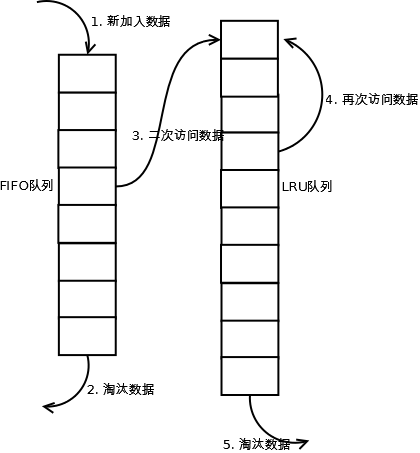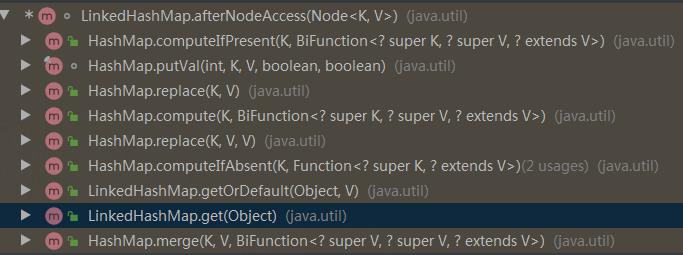[TOC]
LRU
LRU是Least Recently Used的缩写,即最近最少使用,是一种常用的页面置换算法,选择最近最久未使用的页面予以淘汰。该算法赋予每个页面一个访问字段,用来记录一个页面自上次被访问以来所经历的时间 t,当须淘汰一个页面时,选择现有页面中其 t 值最大的,即最近最少使用的页面予以淘汰。
原理
如图

- 新数据插入到链表头部;
- 每当缓存命中(即缓存数据被访问),则将数据移到链表头部;
- 当链表满的时候,将链表尾部的数据丢弃。
实现
在进行实现前,以栈为例,整理下要实现的2个特性:
- 最新被访问的元素要移动到栈顶
- 当新插入一个元素后,栈的长度不够用了,需要移除栈底的元素(即最近最少使用的元素)
实现一
实现一利用LinkedHashMap的特性,重写removeEldestEntry就可以完成LRU算法,先看代码:
import java.util.LinkedHashMap;
import java.util.Map;
/**
*
* @author shijianpeng
*/
public class LRU<K, V> {
private static final float hashLoadFactory = 0.75f;
private LinkedHashMap<K, V> map;
private int cacheSize;
public LRU(int cacheSize) {
this.cacheSize = cacheSize;
int capacity = (int) Math.ceil(cacheSize / hashLoadFactory) + 1;
map = new LinkedHashMap<K, V>(capacity, hashLoadFactory, true) {
private static final long serialVersionUID = 1;
@Override
protected boolean removeEldestEntry(Map.Entry eldest) {
return size() > LRU.this.cacheSize;
}
};
}
public synchronized V get(K key) {
return map.get(key);
}
public synchronized void put(K key, V value) {
map.put(key, value);
}
public void print() {
for (Map.Entry<K, V> entry : map.entrySet()) {
System.out.print(entry.getValue() + "--");
}
System.out.println();
}
public static void main(String args[]) {
LRU<String, String> ss = new LRU(5);
ss.put("1", "3");
ss.put("2", "4");
ss.put("3", "6");
ss.put("4", "1");
ss.put("5", "5");
ss.print();
System.out.println("---------------");
ss.get("1");
ss.print();
System.out.println("---------------");
ss.put("7", "10");
ss.print();
}
}
下面来看为什么,首先看实现代码我们重写了removeEldestEntry方法,那么就来看官方的JavaDoc,此方法的作用:
/**
* Returns <tt>true</tt> if this map should remove its eldest entry.
* This method is invoked by <tt>put</tt> and <tt>putAll</tt> after
* inserting a new entry into the map. It provides the implementor
* with the opportunity to remove the eldest entry each time a new one
* is added. This is useful if the map represents a cache: it allows
* the map to reduce memory consumption by deleting stale entries.
*
* <p>Sample use: this override will allow the map to grow up to 100
* entries and then delete the eldest entry each time a new entry is
* added, maintaining a steady state of 100 entries.
* <pre>
* private static final int MAX_ENTRIES = 100;
*
* protected boolean removeEldestEntry(Map.Entry eldest) {
* return size() > MAX_ENTRIES;
* }
* </pre>
*
* <p>This method typically does not modify the map in any way,
* instead allowing the map to modify itself as directed by its
* return value. It <i>is</i> permitted for this method to modify
* the map directly, but if it does so, it <i>must</i> return
* <tt>false</tt> (indicating that the map should not attempt any
* further modification). The effects of returning <tt>true</tt>
* after modifying the map from within this method are unspecified.
*
* <p>This implementation merely returns <tt>false</tt> (so that this
* map acts like a normal map - the eldest element is never removed).
*
* @param eldest The least recently inserted entry in the map, or if
* this is an access-ordered map, the least recently accessed
* entry. This is the entry that will be removed it this
* method returns <tt>true</tt>. If the map was empty prior
* to the <tt>put</tt> or <tt>putAll</tt> invocation resulting
* in this invocation, this will be the entry that was just
* inserted; in other words, if the map contains a single
* entry, the eldest entry is also the newest.
* @return <tt>true</tt> if the eldest entry should be removed
* from the map; <tt>false</tt> if it should be retained.
*/
protected boolean removeEldestEntry(Map.Entry<K,V> eldest) {
return false;
}
JavaDoc大致翻译如下:
如果这个Map应该删除最老的entry则需要返回true。
这个方法在插入一个新的entry到map里之后被put和putAll调用。
它提供了实现者,每次有新entry被添加时都有机会删除最老的条目。
如果map表示缓存,这很有用:它允许通过删除过时项来减少内存消耗。
简单使用:
此重写将会允许map增大到100个entry,然后每次增加新的entry将会删除最老的entry,保持100个entry的状态。
此方法通常不以任何方式修改映射,相反允许映射在其返回值的指引下进行自我修改。使用此方法直接修改映射是允许的,但是如果它执行了此操作,则一定返回false(表示该映射不应进行任何进一步的修改)。在此方法中修改映射后是否返回true是不确定的。
此实现仅返回 false(这样,此映射的行为将类似于正常映射,即永远不能移除最旧的元素)。
简单一点来说:
removeEldestEntry返回true表示需要移除最老的元素,返回false,则表示不需要移除最老的元素。
通过方法调用我们发现removeEldestEntry被afterNodeInsertion调用,afterNodeInsertion又被新加元素的方法调用。
void afterNodeInsertion(boolean evict) { // possibly remove eldest
LinkedHashMap.Entry<K,V> first;
if (evict && (first = head) != null && removeEldestEntry(first)) {
K key = first.key;
removeNode(hash(key), key, null, false, true);
}
}
到这里为止,已经知道了LRU中的移除最近未使用的元素是如何被实现的:在每次增加新的元素添加进map中,添加元素完成后,将会根据removeEldestEntry方法的返回值判断是否需要移除最老的元素(当然不仅仅只判断removeEldestEntry的返回值,removeEldestEntry的返回值仅仅是一个必要的条件)。
其次我们再看具体实现的部分:
new LinkedHashMap<K, V>(capacity, hashLoadFactory, true) {
private static final long serialVersionUID = 1;
@Override
protected boolean removeEldestEntry(Map.Entry eldest) {
return size() > LRU.this.cacheSize;
}
};
除了重写removeEldestEntry方法外,还指定了initialCapacity、loadFactor、accessOrder,通过查阅JavaDoc,得到以下释义:
- initialCapacity 初始容量
- loadFactor 加载因子
- accessOrder 排序方式,对于访问顺序,为
true;对于插入顺序,则为false
前两个都可以理解,后面排序方式到底是什么意思呢?下面看2个小例子:
@Test
public void fun1() {
LinkedHashMap<String, String> accessOrderTrue = new LinkedHashMap<>(16, 0.75f, false);
accessOrderTrue.put("1", "1");
accessOrderTrue.put("2", "2");
accessOrderTrue.put("3", "3");
accessOrderTrue.put("4", "4");
System.out.println("accessOrderTrue:" + accessOrderTrue);
accessOrderTrue.get("2");
System.out.println("accessOrderTrue:" + accessOrderTrue);
accessOrderTrue.get("3");
System.out.println("accessOrderTrue:" + accessOrderTrue);
accessOrderTrue.put("5", "5");
System.out.println("accessOrderTrue:" + accessOrderTrue);
}
@Test
public void fun2() {
LinkedHashMap<String, String> accessOrderTrue = new LinkedHashMap<>(16, 0.75f, true);
accessOrderTrue.put("1", "1");
accessOrderTrue.put("2", "2");
accessOrderTrue.put("3", "3");
accessOrderTrue.put("4", "4");
System.out.println("accessOrderTrue:" + accessOrderTrue);
accessOrderTrue.get("2");
System.out.println("accessOrderTrue:" + accessOrderTrue);
accessOrderTrue.get("3");
System.out.println("accessOrderTrue:" + accessOrderTrue);
accessOrderTrue.put("5", "5");
System.out.println("accessOrderTrue:" + accessOrderTrue);
}
运行结果:
// fun1打印如下
accessOrderTrue:{1=1, 2=2, 3=3, 4=4}
accessOrderTrue:{1=1, 2=2, 3=3, 4=4}
accessOrderTrue:{1=1, 2=2, 3=3, 4=4}
accessOrderTrue:{1=1, 2=2, 3=3, 4=4, 5=5}
// fun2打印如下
accessOrderTrue:{1=1, 2=2, 3=3, 4=4}
accessOrderTrue:{1=1, 3=3, 4=4, 2=2}
accessOrderTrue:{1=1, 4=4, 2=2, 3=3}
accessOrderTrue:{1=1, 4=4, 2=2, 3=3, 5=5}
从运行结果看,当accessOrder为false的时候,元素的位置仅仅根据插入顺序,不会随着访问而改变;当accessOrder为true的时候,元素的位置在被访问过后,将会被移动到队尾。
那么看懂了表象,下面再来剖析LinkedHashMap如何完成这个实现的,同样透过源码,我们来看实现:
void afterNodeAccess(Node<K,V> e) { // move node to last
LinkedHashMap.Entry<K,V> last;
if (accessOrder && (last = tail) != e) {
LinkedHashMap.Entry<K,V> p =
(LinkedHashMap.Entry<K,V>)e, b = p.before, a = p.after;
p.after = null;
if (b == null)
head = a;
else
b.after = a;
if (a != null)
a.before = b;
else
last = b;
if (last == null)
head = p;
else {
p.before = last;
last.after = p;
}
tail = p;
++modCount;
}
}
上述代码完成了如何将当前元素移动到队尾的任务,很显然accessOrder决定着是否要做这个操作,那么调用方有哪些呢?

从上图,看出最常用LinkedHashMap.get()等方法都会触发此方法。
小结
当accessOrder为true时,则会把访问过的元素放在链表后面,放置顺序是访问的顺序。 当accessOrder为false时,则按插入顺序来遍历。
看到这里,另外一个特性:最新被访问的元素要移动到栈顶。
就是这样实现的。
拓展
-
是否还有可优化空间?
1、过期策略
传统的过期策略,是以固定的长度,通过对元素的排序,来剔除最近最久未使用的元素。
接触Redis之后,也可以利用Redis的过期时间来实现元素的剔除。